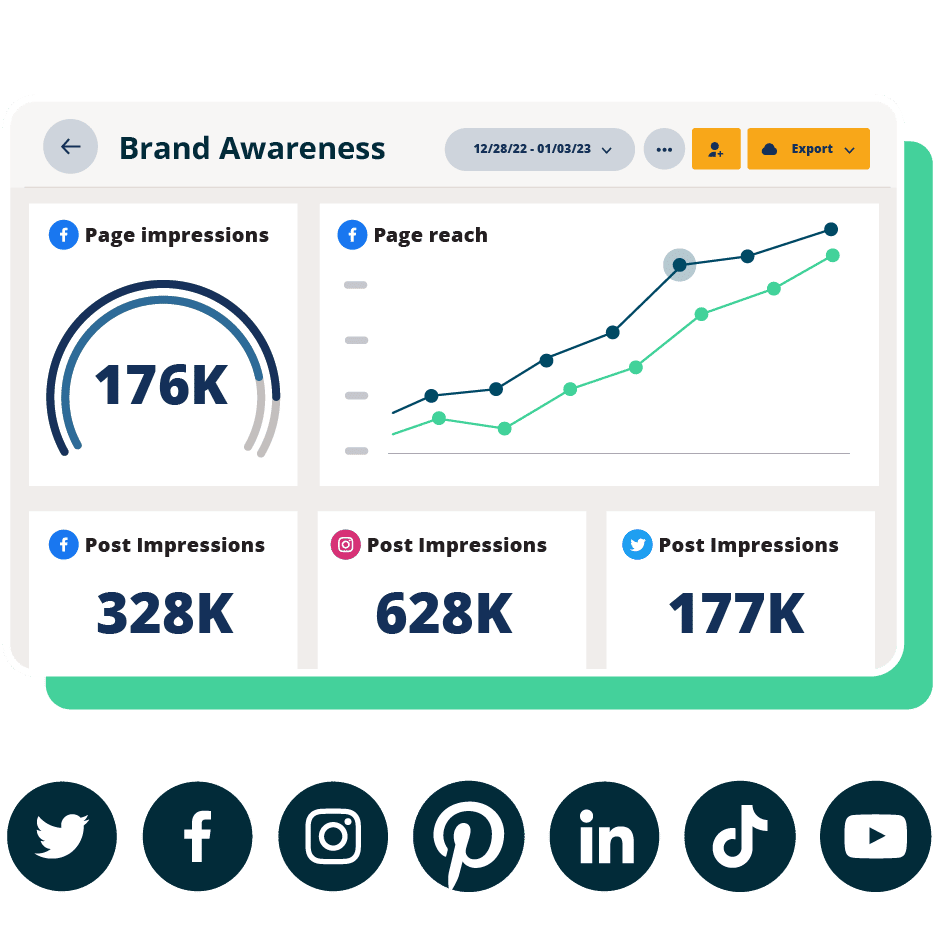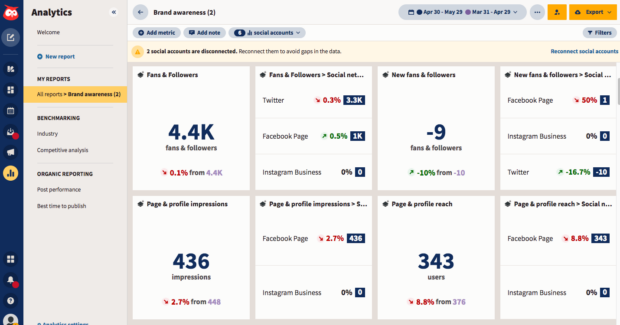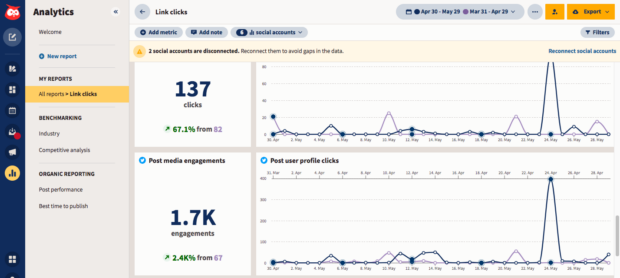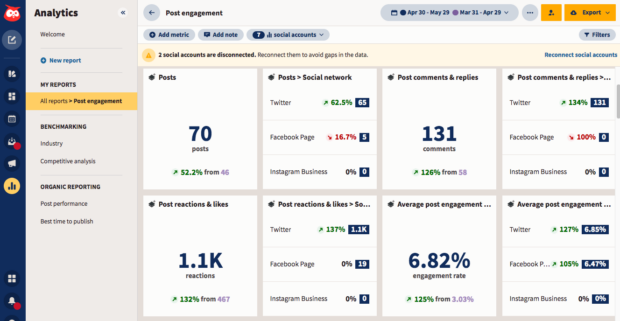Social media analysis and reporting is the heart of a nimble and effective social media strategy. And a social media dashboard is what makes reporting manageable. It allows you to track, analyze, and adjust your social media activity across multiple social media accounts and platforms in one place.
Social media managers have a lot on their plate. A social media dashboard is one of the most useful tools for streamlining workflow. At the same time, it provides critical insights to ensure your social marketing plan reaches its full potential.
Keep reading to learn more about social media dashboards and find out how to use them to work smart, not hard.

#1 Analytics Tool for Growth
Beautiful reports. Clear data. Actionable insights to help you grow faster.
What is a social media dashboard?
A social media management dashboard is a tool used to track, measure, and analyze the performance of your social media channels, all in one place. It can help you understand everything from follower growth to competitor intelligence to social sentiment.
Ideally, your social media analytics dashboard should include visual representations of your data. This makes it easy to spot at a glance how things are changing over time. It’s a living document, and easy comparisons are the name of the game.
How you use a social media dashboard will depend on your social goals and the size of your team. You can use a social media dashboard for a high-level overview of your social performance. Or, dive really deep into extreme detail. Reviewing and sharing your social media dashboard is an important way to learn what’s working and guide your social media strategy.
How to build (and use) a social media dashboard
Using a social media dashboard gives you a clear overview of your social media performance. You can easily see what’s working and what’s not. It also allows you to track your progress and understand how your content is performing.
Here’s how to build—and use—a social dashboard that supports your social media goals.
Understand your goals
Before you can track and analyze your goals, you need to determine exactly what your goals are.
Try to get quite specific in your goals by using the SMART goal-setting framework. SMART goals are:
- Specific
- Measureable
- Achievable
- Relevant
- Time-bound
So, instead of saying your goal is to increase social media followers, you could say that one of your goals is to increase your Instagram follower count by 5% per month. Do some industry benchmarking as part of your goal-setting process to ensure your goals are relevant and achievable.
Determine your metrics and KPIs
Your metrics and KPIs are the numbers you will use to measure your progress towards your goals. Therefore, the metrics and KPIS you choose should align with the language of the goals themselves. Following the example above, if your goal is to increase your Instagram followers, the obvious metric is, well, Instagram followers.
Be sure to think about metrics that can provide deeper insights, too. So, rather than just a count of your followers, it’s helpful to track follower growth rate. This shows how quickly your follower count is growing.
If your goal is to increase engagement, you should also use social listening to track the sentiment of mentions and interactions. This helps you understand whether the engagement you’re seeing has a positive or negative tone. You might also want to specify specific types of engagement to increase, like link clicks or comments.
Set up a data tracking system
A social media analytics dashboard should make it easy to track your performance across all your social media channels. The more data you can gather, the better you’ll be able to understand what’s working and what’s not.
You have a few different data tracking options. The one you choose will depend on the size of your team, how well developed your social presence is, and how much time and money you want to invest.
Manually track your data
When you’re just getting started, a manual dashboard can be a very budget-friendly way to track social media performance. However, it does require more work than the other options.
We’ve got a social media report template to help you track your social data. To retrieve the data, you’ll need to log into the native analytics tools within each of the social media platforms (like Meta Business Suite and Twitter Analytics). You can gather additional data about conversions through Google Analytics.
As you collect your data, simply plug it into the relevant columns on the template. Make sure to use the same time period in each set of reporting tools in order to create a meaningful report.
Bonus: Get a free social media report template to easily and effectively present your social media performance to key stakeholders.
Set up a Google Looker Studio Report
Formerly known as Google Data Studio, Looker Studio is a data visualization platform that can help you understand your social performance.
You can use partner connectors in Looker Studio to connect your social channels to a report and get visualizations of some key social KPIs. If you’ve never used Google Analytics reports, this might feel a little overwhelming. But it can be a good option for those familiar with Google’s reporting tools.
Many of the partner connectors used to automatically import data from social channels have a monthly fee. Another option is to use Google Looker Studio to create a visual report from the data in your Google Sheets social media report template.
Use a social media management tool
A social media management tool like Hootsuite automatically tracks your social data across platforms. This can be a major time-saver, as it eliminates the need to log into multiple tools to gather your details.
All you have to do is connect your social media accounts. Then the data will be ready for you whenever you want to access your social media dashboard. With a few clicks, you can see visual representations of your data for your chosen time period. This is the best social media dashboard option for substantial social teams. (Really — see how we compare to other social media management platforms.)
Check in on your progress regularly
A social media management dashboard adds significant value to your marketing efforts only when you use it regularly. The social landscape changes fast, and you can’t assume that what works today will work tomorrow. Regular check-ins will help you understand how well you’re meeting your goals. It will also serve as an early warning system when things start to change. You can then adapt your strategy appropriately.
It’s also a good idea to have a regular schedule for reporting on your progress. The reporting schedule should align with the timeframes in the goals you set. For example, iIf your goals have a monthly timeline, monthly reports are clearly the best reporting option. But the primary stakeholder should likely check in more often to ensure things are on track. A weekly—or even daily—look at your overview reports gives you the best chance to respond to emerging wins and challenges in real time.
Extract insights from your data
A social media metrics dashboard displays all of your metrics in one place. You can quickly see what’s working and what’s not. It’s taking that next step of putting your findings into action that’s the real benefit of solid social reporting.
For example, say your social media posts are getting a lot of engagement but not many clicks. You might want to focus on creating more shareable content.
Or, say you notice that your audience is most engaged during certain times of day. You can adjust your posting schedule accordingly.
Say you see that social sentiment is trending downward. Or maybe your competitors are suddenly outperforming you. It’s time to do some strategic planning and analysis to uncover the source of the problem before it gets out of hand.
When you understand your social media metrics, you can use that data to create deep insights. You can then shape your marketing strategy to increase conversion rate and fill the sales funnel.
Share your findings
A social media marketing dashboard should make sharing your results with stakeholders easy. Reporting proves the ROI of your social media efforts and helps make a case for further resourcing. Reporting is also important for team learning, whether things are going right or wrong.
Choose a social media reporting dashboard that lets you generate custom reports. Bonus points if you can add schedule reports to send automatically at the intervals best suited to your social media goals.
Keep in mind that not everyone in your reporting structure will need—or even want—the same level of reporting detail. Your social media team members likely want all the information they can get to fuel ideas and discussion.
Your customer service team can benefit from information about inbound messaging and sentiment. But they likely don’t need to know engagement numbers for every post.
Meanwhile, executives and other high-level stakeholders likely want just a high-level view of the metrics most important to ROI like conversions and web traffic.

#1 Analytics Tool for Growth
Beautiful reports. Clear data. Actionable insights to help you grow faster.
6 social media dashboard templates
We tend to think about “a social media dashboard” like it’s just one tool. But the truth is there are many variations on social media dashboards. They all have different uses for analyzing and refining your social strategy.
Here are 6 social media marketing dashboards that should be part of your reporting plan.
Awareness dashboard
An awareness dashboard helps you understand the overall picture of your brand awareness on social media. You’ll see how much your audience is interacting with your social accounts, and how your followers and engagement change over time.
- Why you need it: Understand how much of your target audience is aware of your brand. How much do they interact with your brand across social platforms?
- What it measures: Follower growth, impressions, reach, mentions, engagement, link clicks
- Where the data comes from: Facebook, Instagram, Twitter, TikTok, LinkedIn
Conversion dashboard
Conversion is important because it shows your social media efforts are helping to drive real business results. When people click through from your social channels to your blog or website, they’re taking on a deeper level of engagement with your brand. They’re taking the first step toward becoming a customer.
- Why you need it: Understand how much traffic your social channels are driving to your website
- What it measures: Link clicks; user profile clicks; and calls, texts, and email clicks from CTA buttons
- Where the data comes from: Facebook, Instagram, Twitter, LinkedIn
Engagement dashboard
Engagement shows that people are not just seeing your social posts but taking the time to interact with your brand on social channels. Increasing engagement rate is an ongoing quest for social media managers. This is the dashboard you need to track and report on related metrics and goals.
- Why you need it: Understand how (and how often) your audience engages with your posts
- What it measures: Overall engagement, comments, replies, likes, reactions, shares, photo views, engagement by media type, top posts
- Where the data comes from: Facebook, Instagram, Twitter, TikTok, LinkedIn
Audience growth dashboard
Ideally, your social content should consistently reach new people. Audience growth helps you understand the way your social following changes over time.
- Why you need it: Learn how your audience is growing or shrinking over time, so you can understand the potential impact of your social presence
- What it measures: Follower count, follower growth, page & profile impressions, page & profile reach, sources of new and lost followers
- Where the data comes from: Facebook, Instagram, Twitter, TikTok, LinkedIn
Competitor overview dashboard
Social media is an incredibly rich source of competitive analysis. Keeping an eye on your competitors’ performance as well as your own gives you a deeper understanding of social trends in your niche.
- Why you need it: Understand how your social performance compares to that of your most important competitors
- What it measures: Followers, follower growth, and posts—yours versus your competitors
- Where the data comes from: Facebook, Instagram, Twitter
Network-specific dashboards
After getting the bird’s-eye view of your social performance from overview dashboards, it’s a good idea to dive deeper into your performance in individual channels. This allows you to understand the differences between social networks. You can then create a network-specific social strategy to get the best results.
- Why you need it: Get network-level performance details to guide the specifics of your social strategy
- What it measures: Reactions, shares, follower growth, social sentiment, demographics, when fans are online, clicks
- Where the data comes from: Facebook, Instagram, Twitter, LinkedIn, TikTok
Start a free 30-day Hootsuite trial, and get access to all these features. Easily track your social media performance and maximize your budget. Publish all your posts and analyze the results in the same, easy-to-use dashboard. Try it free today.
Do it better with Hootsuite, the all-in-one social media tool. Stay on top of things, grow, and beat the competition.
The post 6 Social Media Dashboards To End Manual Data Tracking appeared first on Social Media Marketing & Management Dashboard.











Recent Comments